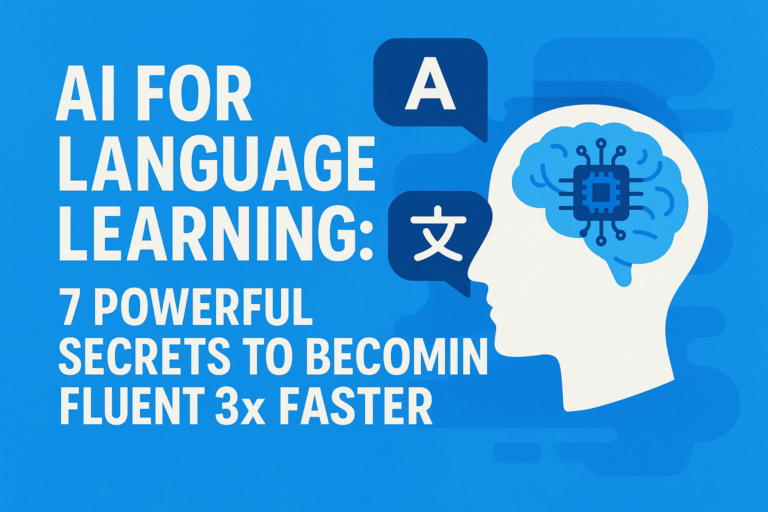Stop wasting time and money learning AI. Discover the best free AI courses available and gain a strategic advantage in a fraction of the time.
The bottom line for most businesses isn’t just about cutting costs—it’s about amplifying value where innovation happens. But discovering new technologies and profiting from them is easier said than done. Today, with Artificial Intelligence driving workflows from personalized marketing to sophisticated data analysis, many organizations realize they cannot wait until AI “becomes mainstream” to act. Yet, one of the biggest barriers to entry is the [Free AI Courses] challenge: How do you acquire the skills and create an AI-powered strategy without spending thousands?
The Strategic Toolkit: Building Your Foundation
Before diving into the world of expensive AI certifications or complex software, you need a solid strategic foundation. Consider the following key components:
- Understand Your Core Business Goals: AI is a powerful tool, but it needs a purpose. Are you looking to improve customer acquisition, streamline internal operations, provide more insights to your marketers, or fulfill a unique pain point?
- Define Your Target Audience: Who will benefit from your AI-powered initiatives, and who are you trying to solve a problem for?
Essential AI Software Tools (Many with Free Access)
While free AI courses often cover theoretical understanding, strategic implementation requires practical tools. Here are a few leading platforms that provide both learning resources and accessible tools (for practice or integration):
- OpenAI: A key player in conversational AI and language models. Beyond their online resources and API access (which has a paid element but offers generous free tiers for exploration), OpenAI provides tutorials and use cases that are managed directly through their platform. Experiment with prompt engineering and GPT models here without upfront costs.
Pro-Tip: Start by fine-tuning how to get the most relevant responses out of ChatGPT for your specific tasks.
- Hugging Face: A hub for open-source AI models, perfect for developers and those looking to integrate powerful AI features into their existing tools. They offer courses and a playground to experiment, requiring little more than an account. Many models are free to use, though some have usage limits.
- Google AI Studio: Part of Google Cloud’s suite of AI offerings, the AI Studio provides easy access to various machine learning models and tools. While linking directly to a free tool can sometimes involve minor technical steps or understanding your existing Google services, the foundational aspects are accessible. Explore natural language processing, image recognition, and more.
The Guiding Role of Human Expertise
Recognizing the AI tools you need and knowing how to use them strategically requires understanding your business. These courses teach the ropes, but your business acumen and clear goal-setting ensure responsible and valuable deployment.
Time & Resource Investment: Manual vs. AI-Powered Shift
The speed and efficiency of artificial intelligence often lead to startling ROI numbers. Here’s a rough comparison:
The Manual Method: Imagine needing to generate compelling marketing copy for a campaign. This might involve brainstorming, drafting several options, potentially delaying the campaign until the final copy is perfected. Market research could take weeks. This method consumes direct labor hours and often dilutes focus across multiple tasks.
The AI-Powered Method: Using the prompts learned in a [best free AI training] course alongside a platform like OpenAI, you could generate different marketing message drafts in a matter of minutes. Real-time analysis of customer reviews or sentiment could provide nuanced feedback for your campaigns within days instead of weeks.
Let’s quantify this. If the manual method requires 80 hours per month for repetitive AI-relevant tasks and the introduction of AI optimizes one of these tasks by being 90% faster, you’re saving 72 hours per month.
The Implementation Blueprint: How to Apply It
Successfully implementing AI, even through self-guided learning with Free AI Courses, involves phased steps:
Step 1: Evaluate Your Needs: Identify a specific, repeatable process within your business that you suspect AI could improve.
Step 2: Choose and Autenticate: Pick one or two of the free AI services mentioned (e.g., ChatGPT for content, Hugging Face for classification). Read their instructions carefully.
Step 3: Test and Refine: Run small experiments using sample data to see how useful the AI is for your specific problem. Analyze its outputs – are they relevant, strategic value? are they falling short?
Step 4: Iterate. As you progress through tools and guides like those acquired via free AI courses, focus on automating insights or outputs where the investment is clear.
Step 5: Scale Prudently: Once the AI solution is providing tangible benefits with your data, consider expanding or automating it more completely, potentially via paid connections.
“[Strategy Note]* Start small, document the results precisely, and focus on explaining the impact to your team or leadership—ROI speaks for itself.”*
Measuring Success: Key Business Metrics
You need to demonstrate value to stakeholders. Track these KPIs:
| Metric | What It Tells You |
|---|---|
| Reduction in Task Time | How efficiently AI is accelerating workflows compared to manual operations. |
| Conversion Rate | Measuring changes in revenue, fewer drop-offs, or higher engagement post-AI integration. |
| ROI (Return on Investment) | Calculating the direct financial gain from using AI. Crucial for scaling your efforts. |
| Customer Satisfaction | Measuring if AI-driven personalization or efficiency is having a positive effect on user experience. |
Scaling & Advanced Strategies: From Basics to Cutting Edge
Once you’ve mastered the initial [Learn AI for free] approach via these free AI courses, how do you move beyond?
- Integrate With Existing Tools: Combine AI outputs with your CRM, marketing automation platforms, or customer support systems using APIs learned through dedicated free AI courses.
- Explore Niche AI Applications: Depending on your industry, look at AI in validation (e.g., checking data accuracy) or in recommendation engines (personalized content or product suggestions).
- Become a Content Creator in the AI-Space: Share your journey (processes you automated, pitfalls you avoided) on relevant industry blogs, leveraging platforms like How to Make Money in AI for inspiration.
Strategic Business Applications: How Different Businesses Use These Techniques
- B2B SaaS Companies: Use AI to automate customer support tickets, analyze feedback trends to improve subscriptions, and personalize discovery emails.
- E-commerce Stores: Leverage AI for dynamic product descriptions and targeted advertising campaigns based on previous search and purchase behavior.
- Digital Marketing Agencies: Quickly format reports, brainstorm ad creative concepts, and generate compelling social media content tailored to audience segments.
Common Strategic Pitfalls to Avoid
Even with free AI courses, implementation can derail if you ignore these common pitfalls:
- Treating AI as a Silver Bullet: AI requires clear strategy and context. Without proper setup, you get outputs but not meaningful results. Context remains king.
- Overlooking Integration and Scalability: AI projects shouldn’t exist in a silo. They only deliver their maximum benefit when embedded into the core workflows. Don’t treat them as isolated experiments.
- Ignoring Data Quality and Ethics: AI models rely heavily on data. Ensure the data underpinning your explorations is both relevant and respectful of user privacy (GDPR, CCPA).
Building Your Content Engine: Systems & Automation
This isn’t about one AI tool or one script. It requires craftaico’s vision for building sustainable AI-driven processes. Think of this as a flywheel: your free AI courses provide the initial fuel, you build the wheel (your implementation), and now the momentum helps identify the next optimizations or expansions. This system approach ensures AI doesn’t just happen once, but informs your entire strategy for innovation.
Let’s Build Your AI Advantage Together
This guide provides a blueprint for acquiring the knowledge and implementing AI solutions, not through overwhelming commitments of time or money, but by leveraging the amazing [Learn AI for free] resources readily available today.
But every journey starts with a single step, and whose journey is more powerful than that of a CEO championing AI integration?
Share how your organization can benefit from AI: Tell us your biggest challenge below!
In the meantime, let’s talk about your AI strategy. Schedule a Call to explore how we can build an optimized AI roadmap for your business.
Frequently Asked Questions
Q1: Where are you getting all your knowledge from these days? What expert courses are included?
Many of the cutting-edge insights come from renowned platforms like Coursera, edX, and the ones discussed above. These trusted free AI courses are vetted by industry leaders and data professionals.
Q2: This seems powerful—but isn’t AI extremely complicated? It’s for developers, right?
Not necessarily. You may be shocked to learn how accessible these [best free AI training] programs and tools have become. The right focus is strategic application. Your goal is to know what to ask AI and why, not the complex coding.
Q3: So I don’t need to employ a full-time AI data scientist? Or is that still necessary?
You don’t need a team for the beginning. The insights, accessible through free AI courses, allow smart, forward-thinking business owners to guide AI towards strategic objectives. Data scientists handle architecture, but their core reasoning skills are replaceable by well-defined tasks.




